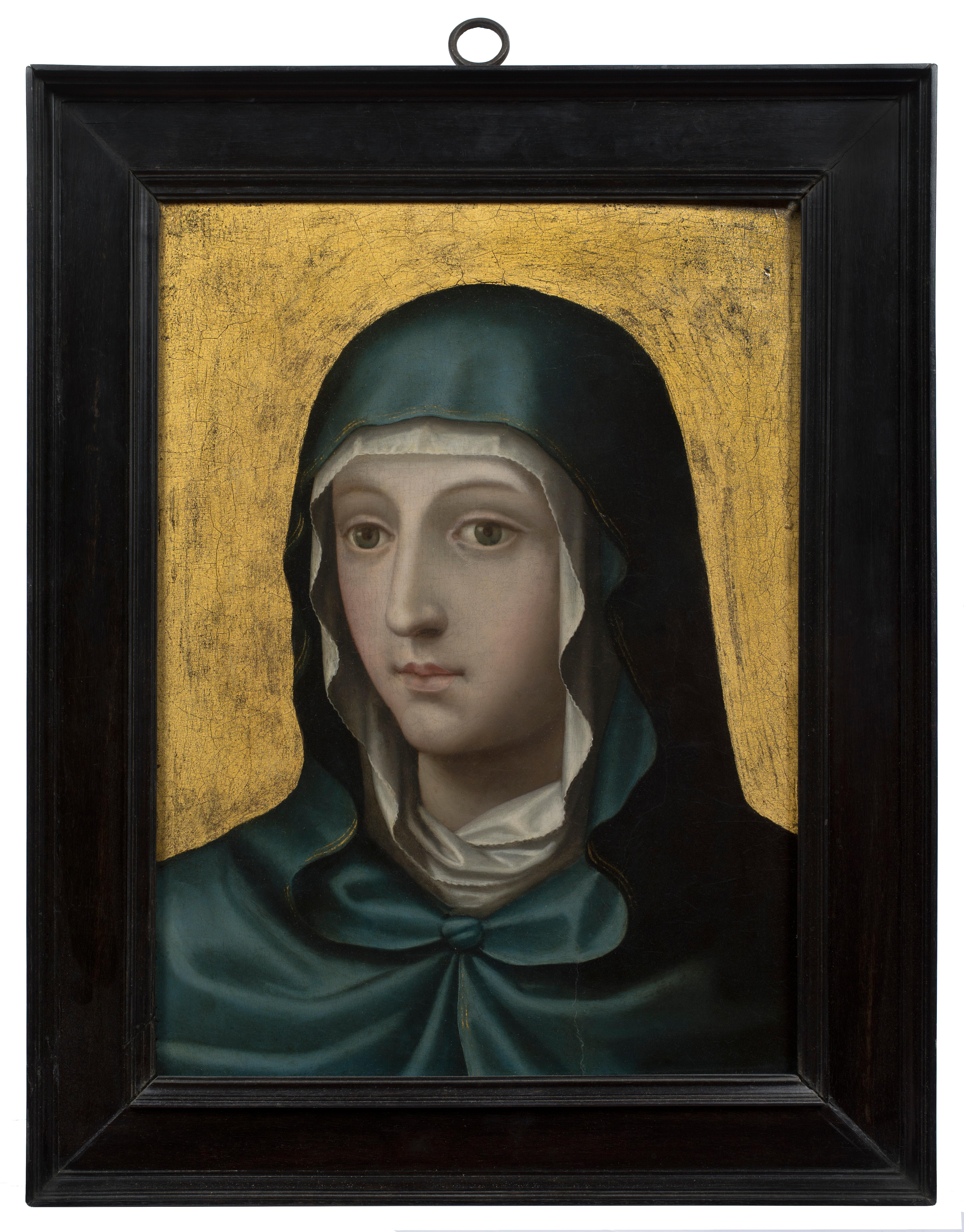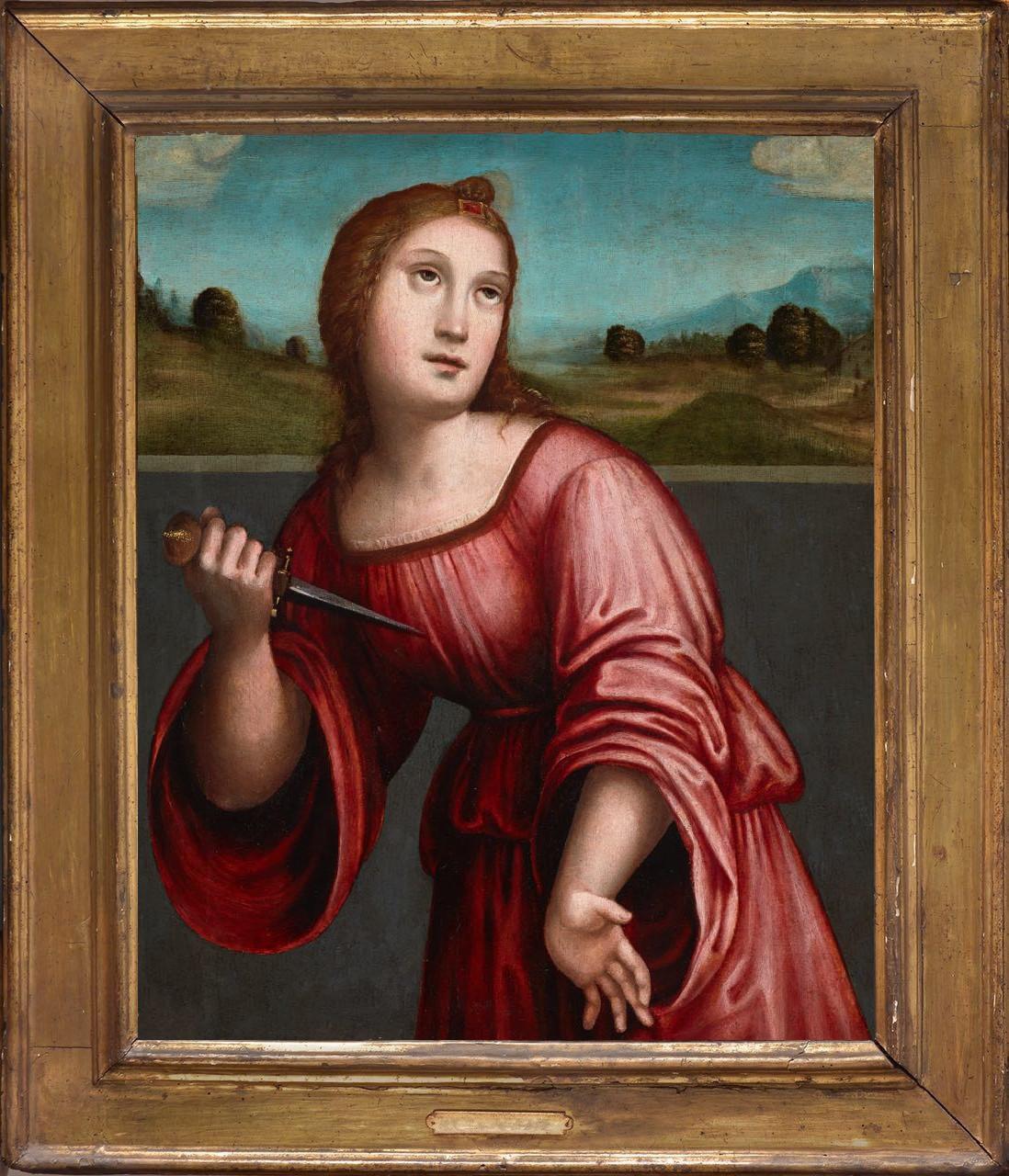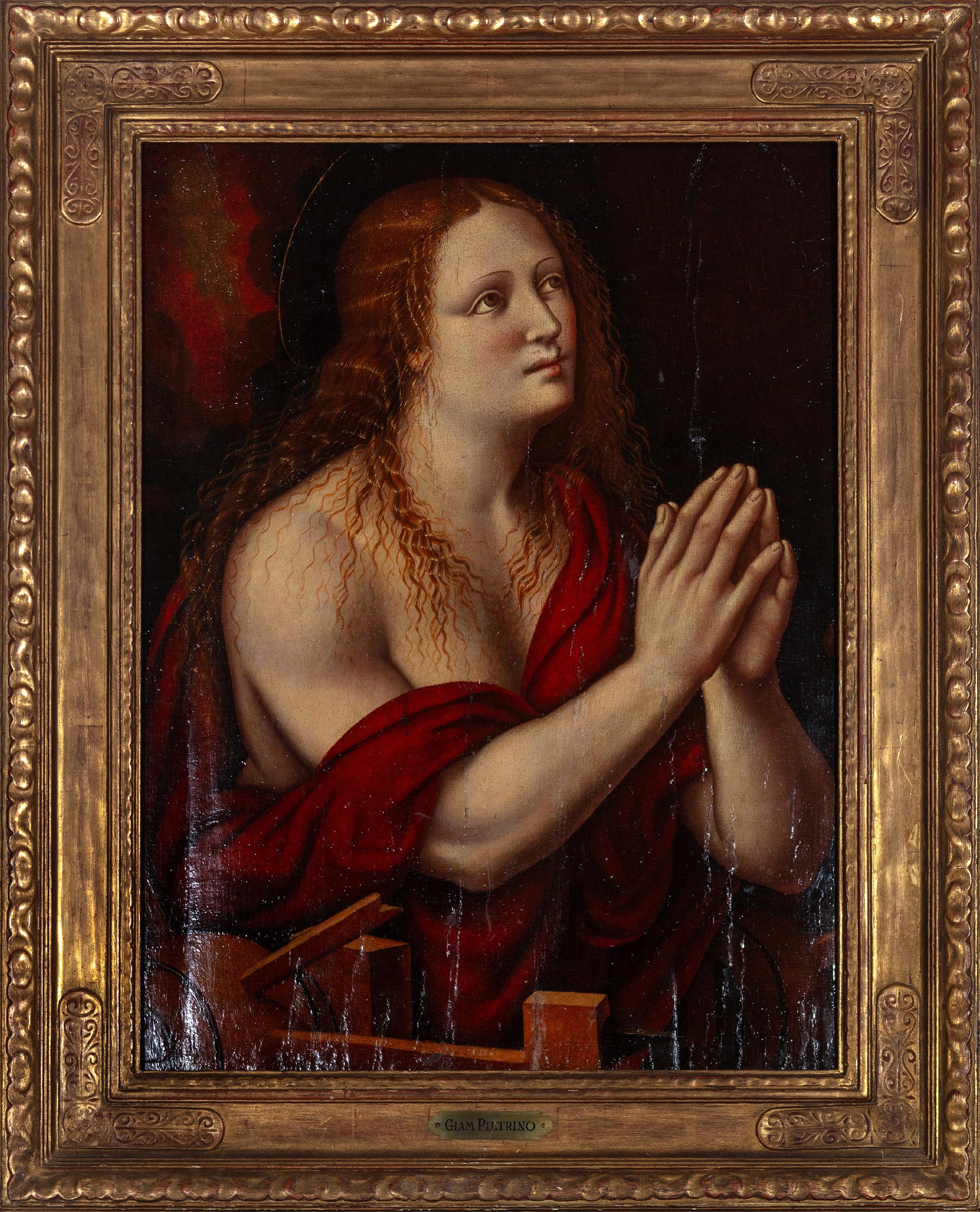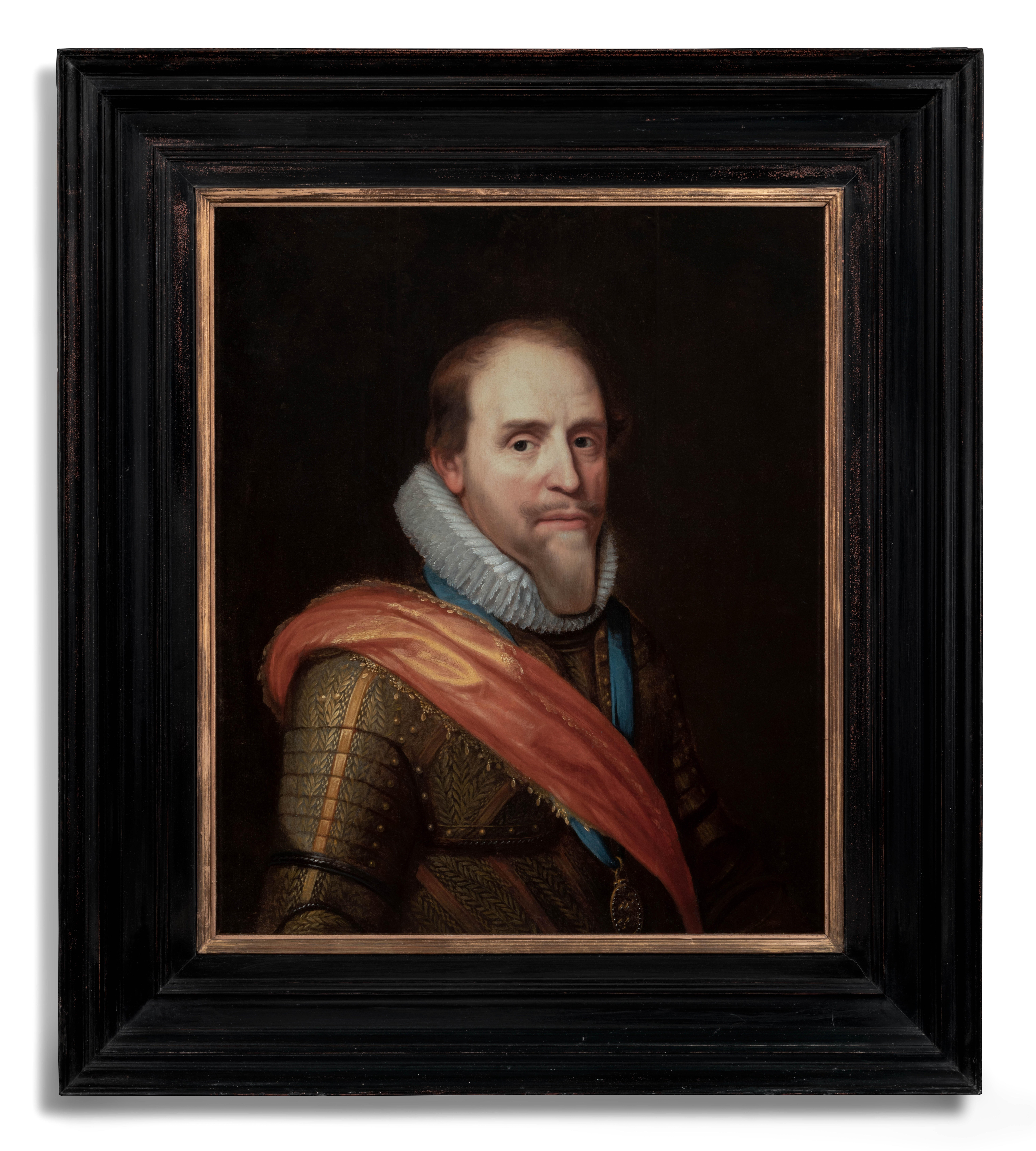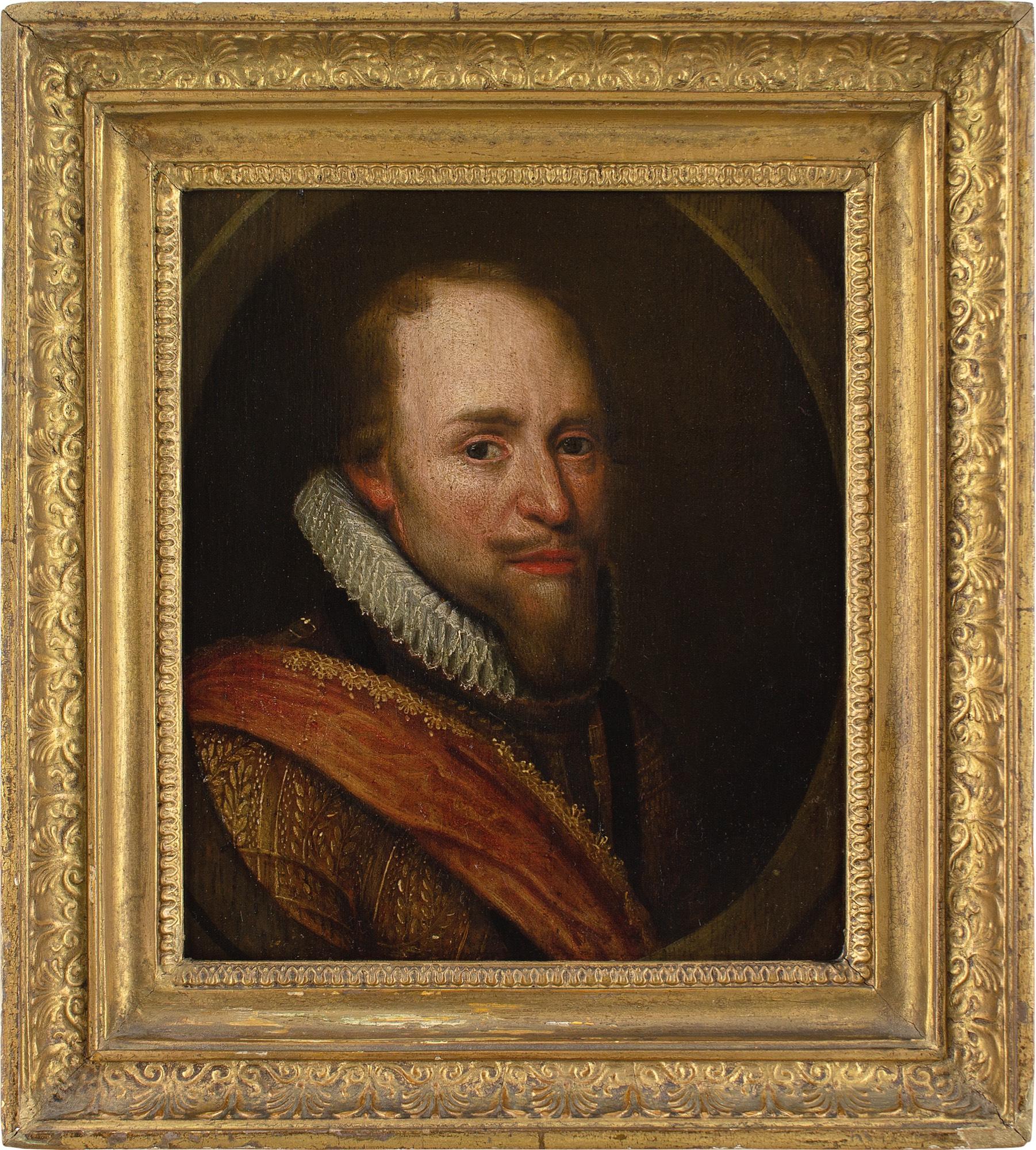Items Similar to Man in Tavern Smoking a Pipe /// Old Masters Dutch David Teniers Portrait Face
Want more images or videos?
Request additional images or videos from the seller
1 of 14
Man in Tavern Smoking a Pipe /// Old Masters Dutch David Teniers Portrait FaceCirca: 1690
Circa: 1690
About the Item
Artist: Unknown (Circle of David Teniers the Younger, Flemish, 1610-1690)
Title: "Man in Tavern Smoking a Pipe"
*No signature found
Circa: 1690
Medium: Original Oil Painting on Wooden Board
Framing: Framed in an antique gold gesso frame
Framed size: 10" x 9"
Board size: 6" x 4.88"
Condition: Cosmetic wear to framing. The painting is in very good condition
Notes:
Provenance: private collection - Cleveland, OH. Red wax seal with unidentified collector's mark resembling a bird perched on a branch on verso.
Biography:
David Teniers the Younger (1610-1690) was a 17th-century Flemish painter known for his luminous depictions of peasant life. His work was greatly influenced by the tavern scenes of Adriaen Brouwer and the fluid paint handling of Peter Paul Rubens. Born on December 15, 1610 in Antwerp, Belgium, he was the son of the artist David Teniers the Elder, with whom he studied as a youth. Notably, Teniers later married the daughter of the painter Jan Brueghel the Elder. In the early 1630s, the Haarlem-based painter Brouwer moved to Antwerp, Teniers exposure to his low-genre paintings was a turning point in his career. Over the following decades, he enjoyed a popular reputation around Europe. Though most of his works were modest in scale, he was a prolific artist and is thought to have completed some 2,000 paintings over the course of his career. Teniers died on April 25, 1690 in Brussels, Belgium. Today, his work can be found in the Louvre in Paris, the National Gallery of Art in London, the Hermitage Museum in St. Petersburg, and the Rijksmuseum in Amsterdam, among others.
- Creation Year:Circa: 1690
- Dimensions:Height: 10 in (25.4 cm)Width: 9 in (22.86 cm)
- Medium:
- Movement & Style:
- Circle Of:David Teniers the Younger (1610 - 1690, Flemish)
- Period:1690-1699
- Condition:(Very Good).
- Gallery Location:Saint Augustine, FL
- Reference Number:1stDibs: LU121210063252
About the Seller
5.0
Platinum Seller
These expertly vetted sellers are 1stDibs' most experienced sellers and are rated highest by our customers.
Established in 1978
1stDibs seller since 2015
1,221 sales on 1stDibs
Typical response time: <1 hour
- ShippingRetrieving quote...Ships From: Saint Augustine, FL
- Return PolicyA return for this item may be initiated within 3 days of delivery.
More From This SellerView All
- Cowboy /// Contemporary Pop Portrait Painting Funny Man Sheriff Dan May AmericanBy Dan MayLocated in Saint Augustine, FLArtist: Dan May (American, 1955-) Title: "Cowboy" *Signed by May upper right Circa: 2020 Medium: Original Acrylic Painting on Board Framing: Framed in a contemporary black moulding F...Category
2010s Contemporary Portrait Paintings
MaterialsPanel, Paint, Acrylic, Wood Panel, Board
- Portrait of Margaritta MacDonald in red jacket and white gown (half-length)By Sir Henry RaeburnLocated in Saint Augustine, FLArtist: (after) Sir Henry Raeburn (Scottish, 1756-1823) Title: "Portrait of Margaritta MacDonald in red jacket and white gown (half-length)" *No signature found Circa: 1820 Medium: O...Category
1820s Baroque Portrait Paintings
MaterialsCanvas, Paint, Oil, Gesso
- Criminal #23 /// Contemporary Pop Art Painting Jail Prisoner Funny Bandit FigureBy Dan MayLocated in Saint Augustine, FLArtist: Dan May (American, 1955-) Title: "Criminal #23" *Signed by May lower left. It is also signed on verso Year: 2018 Medium: Original Acrylic Painting on C...Category
2010s Contemporary Portrait Paintings
MaterialsBoard, Canvas, Paint, Acrylic
- Dutch Fishing Vessels in Storm /// Francis Swaine Maritime Seascape Antique ShipBy Francis SwaineLocated in Saint Augustine, FLArtist: Francis Swaine (English, 1725-1782) Title: "Dutch Fishing Vessels in Storm" *No signature found Circa: 1770 Medium: Original Oil Painting on wood panel Framing: Framed in a Louis XV style gold moulding Framed size: 10.63" x 12.63" Panel size (irregular margins): 6" x 7.75" Condition: One small restored spot upper left. Cosmetic wear to frame. In otherwise very good condition Notes: Provenance: private collection - London, England; acquired from art dealer Ernest Alden, London, England retaining his original gallery label on verso. Metal plaque inscribed "F. Swaine 1740-1782", (active dates), attached to frame bottom center. Ernest William Alden (1866-1947) was recorded in successive censuses, in 1881 as a picture mounter (card maker), age 14, living at 9 Bloomsbury St, with several other members of his family also given as picture mounters, including his father, James; in 1891 as a picture frame mounter with his father and family at 208 Shaftesbury Avenue; in 1901 as a photographer and picture dealer at 39 King’s Road, Chelsea; and in 1911 again at 39 King’s Road but the census form is damaged. His listing in trade directories, initially as picture mount cutter, changed to picture framemaker from 1904, soon after he set up in the King’s Road. He advertised his large stock of second-hand swept and other frames, claiming to have been established in 1893 (The Year’s Art 1913). Alden died in Chelsea in 1947, leaving effects worth £5,011, with probate granted to his widow Lily Alden and to Marjorie Frances Alden. Two of his younger brothers, Henry Cyril Alden (1871-1939) and James Preston Alden (1876-1960), were also active as picture framemakers. - National Portrait Gallery, London, England. Biography: Francis Swaine (1725–1782) was a British marine painter. He was born in 1725, and christened on 7 October of that year at St Dunstan's, Stepney, London. His parents were named Francis Swaine and Ann Joel. In 1735 the elder Francis Swaine, the marine painter's father, applied in writing to the Commissioners of His Majesty's Navy for employment as a Navy Messenger, in succession to Mr William Wyatt. He mentions that he had served "upwards of twenty eight years" in the Navy, and that his father had died Purser of the Royal Katherine. He mentions also that he had carried out "little labours in drawing", and that he at that time had five small children. The first-born of these children was the Francis Swaine who became the marine painter. The elder Swaine was duly employed as a Navy Messenger. He served for 20 years and died on 10 October 1755, aged 64. Swaine is said to have been influenced by the style of Van de Velde. There is no clear evidence of this alleged influence. The suggestion that Swaine may have been a pupil of Charles Brooking...Category
1770s Old Masters Landscape Paintings
MaterialsPaint, Oil, Panel, Wood Panel, Board
- Rosie Huntington-Whiteley Icon IV /// Contemporary Pop Art Fashion ModelBy Jack Graves IIILocated in Saint Augustine, FLArtist: Jack Graves III (American, 1988-) Title: "Rosie Huntington-Whiteley Icon IV" Series: Icon *Signed by Graves lower right. It is also signed, da...Category
2010s Contemporary Portrait Paintings
MaterialsCanvas, Paint, Acrylic
- Ecstasy of Saint Teresa Icon III (Bernini) /// Renaissance Italian Classics RomeBy Jack Graves IIILocated in Saint Augustine, FLArtist: Jack Graves III (American, 1988-) Title: "Ecstasy of Saint Teresa Icon III (Bernini)" Series: Icon *Signed by Graves lower left. It is also signed...Category
2010s Contemporary Portrait Paintings
MaterialsAcrylic, Canvas, Paint
You May Also Like
- The Veronica of the Virgin (Verónica de la Virgen)Located in New York, NYThe panel has been attributed both to Joan de Joanes and his son Vicente Macip Comes (Valencia, ca. 1555 – 1623). Provenance: Private Collection, England, by 1886 (according to stencils on the reverse) Private Collection, New Jersey, until 2010 The Veil of Veronica, often called the Sudarium, is one of the most important and well-known relics of Christ. According to legend, Veronica offered Christ her veil as he carried the cross to his crucifixion. He wiped his face with the veil, which left the cloth miraculously imprinted with his image. Depictions of Christ’s face on a veil, or simply images that focused in on Christ’s face, were treasured objects of religious devotion. The popularity of this format also inspired similar images of the face of the Virgin. The iconographic type of the present painting is known as the Veronica of the Virgin, which was especially favored in late medieval and early Renaissance Spain. Distinct from the images of the suffering Christ, the Veronica of the Virgin is based on the legend that Saint Luke painted a portrait of Mary from life. Although scholars have sometimes mistaken them for portraits of Queen Isabella I of Castile (known as Isabel la Católica) or as a depiction of Saint Maria Toribia (known as María de la Cabeza, or, Mary of the Head), paintings like this one were clearly intended as images of the Virgin in the style of Saint Luke’s lost portrait. The Veronica of the Virgin was especially popular in Valencia, and depictions of this subject produced there all stem back to one visual prototype: a Byzantine image in the city’s cathedral (Fig. 1). This early treatment of the Veronica was given to the cathedral in 1437 by Martin the Humane, King of Aragon and Valencia, who promoted religious veneration of the Veronica of the Virgin as part of the celebration of the Immaculate Conception of Mary. This devotion spread throughout Martin’s kingdom and particularly took hold in Valencia, where the Byzantine image resided. The image, which is displayed in a gold reliquary...Category
16th Century Old Masters Paintings
MaterialsOil, Wood Panel
- Lucretia, by Giacomo Raibolini Francia. Detto il Francia. Oil on panel, framedLocated in Brooklyn, NYGiacomo used to paint with his brother Giulio, identifying their works with the monogram «I I». The strong influence of his father, Francesco, is undeniable in all his works, althoug...Category
16th Century Old Masters Figurative Paintings
MaterialsOil, Wood Panel
- "Caterina d'Alexandria (Saint Catherine of Alexandria)" classical religiousBy (After) GiampietrinoLocated in Milwaukee, WI"Caterina d'Alexandria (Saint Catherine of Alexandria)" is an original oil painting on wood panel, likely painted by Italian artist Giampietrino (Giovanni Pietro Rizzoli). The painti...Category
19th Century Old Masters Portrait Paintings
MaterialsOil, Wood Panel
- Dutch Old Master Portrait of Maurits, Prince of Orange-Nassau, Oil on PanelLocated in London, GBIn 1607, the Delft city council decided to commission a portrait of Stadholder Maurits of Nassau for the town hall, with Michiel van Mierevelt as the chosen artist due to the passing...Category
17th Century Old Masters Portrait Paintings
MaterialsOil, Wood Panel
- Portrait of a Lady in an Elaborate Ruff & Lace Coif c.1610-20, Dutch Old MasterLocated in London, GBThis magnificent oil on panel portrait, presented by Titan Fine Art, is a splendid example of the sumptuous female portraits that were painted for members of the upper echelons of society during the early part of the 1600’s. The artist has rendered this portrait with meticulous attention to detail and the surface effects of the fine materials. The elaborate lace coif and cuffs are painstakingly delineated, as is the bold black damask, and sumptuous gold decoration of her skirt and stomacher, which is wonderfully preserved and quite remarkable considering the age of the work and the fact that darker pigments are particularly vulnerable to fading and wear. This work with its spectacular depiction of costume is of absolute quality, it can be rated as one of the best works in the artist’s oeuvre and as such it is an important and splendid example of Dutch portraiture. The Dutch Golden Age of painting was a period in Dutch history, roughly spanning the 17th century, in which Dutch trade, science, military, and art were among the most acclaimed in the world. Dutch explorers charted new territory and settled abroad. Trade by the Dutch East-India Company thrived, and war heroes from the naval battles were decorated and became national heroes. During this time, The Dutch Old Masters began to prevail in the art world, creating a depth of realistic portraits of people and life in the area that has hardly been surpassed. The Golden Age painters depicted the scenes that their discerning new middleclass patrons wanted to see. This new wealth from merchant activities and exploration combined with a lack of church patronage, shifted art subjects away from biblical genres. Dress was a key component in portraits, and the exuberant attire reiterates the incredible wealth of this woman. The sitter will have visited the artist’s workshop and inspected examples on display. They would have chosen the size and the sort of composition and on that basis negotiated the price – which would have also been determined by the complexity of the clothing and the jewels that were to be depicted, and by the materials to be used. When all was considered, this portrait would have cost the sitter (or her husband) a substantial sum. The colour black was regarded as humble and devout yet at the same time refined and sophisticated and the most expensive colour of fabric to dye and to maintain. Citizens spent fortunes on beautiful black robes. Such uniformity must also have had a psychological side-effect and contributed to a sense of middle-class cohesion; the collective black of the well-to-do burgess class will have given its members a sense of solidarity. The colour was always an exciting one for artists and when this portrait was painted there were at least fifty shades of it, and as many different fabrics and accoutrements. Artists went to great lengths to depict the subtle nuances of the colour and the fabrics and textures and how they reflected light and it was an ideal background against which gold and crisp white lace could be juxtaposed to dramatic effect. The sitter is either a married women or a widower as is evident by the clothing that she wears and the position, toward her right, it is highly likely that this portrait was once a pendant that hung on the right-hand side of her husband’s portrait as was convention at the time. She wears a vlieger which was a type of sleeveless over-gown or cape worn by well-to-do married women in the late 16th and early 17th centuries. Variations with short sleeves or high shoulder rolls are known. Sometimes sleeves were attached with aiglets, and often slits were made to allow belts or the hands to pass through. Three-piece vlieger costumes of this kind were standard items of clothing in portraits of the women of the civic elite in the period 1600-40 and was a variant of the Spanish ‘ropa’ and served as a trademark of well-to-do married burgher women. Girls and unmarried woman, including beguines, wore a bouwen (a dress with a fitted bodice and a skirt that was closed all round) instead. This clear distinction between apparel for married and unmarried women is clear not only from inventories and trousseau lists, but also from contemporary sources such as the Dutch Spanish dictionary published by Juan Rodrigues in 1634. In it, a bouwen is described as a ‘ropa de donzella’ (over-gown worn by a virgin) and a vlieger as a ‘ropa de casada’ (overgown worn by a married woman). It is striking how few women are depicted wearing a bouwen, unless they are part of a group, family or children’s portrait and it can therefore be assumed that independent portraits of unmarried women were seldom commissioned. It is also believed that the clothing worn in these portraits existed and were faithfully reproduced when cross-referenced with the few exact documents. These sources also demonstrate that clients wanted their clothing to be depicted accurately and with this in mind precious garments and jewels were often left in the painter’s studio. The prominent white lawn molensteenkraag (or millstone ruff) is held up by a wire supportasse and was reserved only for the citizens that could afford this luxurious item that often required 15 meters of linen batiste. The fabulous wealth of this sitter is also evident by the elaborate lace coif and cuffs which have been exquisitely depicted; lace was often literally copied by artists in thin white lines over the completed clothing. The gold bracelet with jewels is a type that was evidently fashionable as it is seen in a number of portraits during the 1610s and 1620. Clothing and jewellery were prized possessions and were often listed in inventories of estates and passed down from generation to generation. There were a great number of jewellers of Flemish origin working at all the courts and cities of Europe, competing with the Italians, and then the French, adapting themselves to the tastes and positions of their patrons and the raw materials available in the country where they worked. The fashion for jewels “in the Flemish style” succeeded that of the Italian style. Cornelis van der Voort, who was probably born in Antwerp around 1576, came to Amsterdam with his parents as a child. His father, a cloth weaver by trade, received his citizenship in 1592. It is not known who taught the young Van der Voort to paint, but it has been suggested that it was either Aert Pietersz or Cornelis Ketel. On 24 October 1598 Van der Voort became betrothed to Truytgen Willemsdr. After his first wife’s death he became betrothed to Cornelia Brouwer of Dordrecht in 1613. In addition to being an artist, Van der Voort was an art collector or dealer, or both. In 1607 he bought paintings from the estate of Gillis van Coninxloo, and after an earlier sale in 1610 a large number of works he owned were auctioned on 7 April 1614. Van der Voort is documented as appraising paintings in 1612, 1620 and 1624. In 1615 and 1619 he was warden of the Guild of St Luke. He was buried in Amsterdam’s Zuiderkerk on 2 November 1624, and on 13 May 1625 paintings in his estate were sold at auction. Van der Voort was one of Amsterdam’s leading portrait painters in the first quarter of the 17th century. Several of his group portraits are known. It is believed that he trained Thomas de Keyser (1596/97-1667) and Nicolaes Eliasz Pickenoy (1588-1650/56). His documented pupils were David Bailly (c. 1584/86-1657), Louis du Pré...Category
17th Century Old Masters Portrait Paintings
MaterialsOil, Wood Panel
- Michiel Jansz. Van Mierevelt (Follower), Portrait of Maurice of OrangeLocated in Cheltenham, GBThis early to mid-17th-century oil on panel depicts Maurice of Nassau (1567-1625), Prince of Orange. It’s a bust-length portrait, presented in a feigned oval, after a full length by ...Category
Mid-17th Century Old Masters Portrait Paintings
MaterialsOil, Wood Panel
